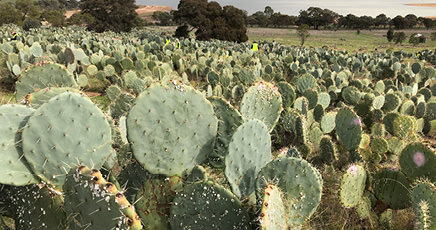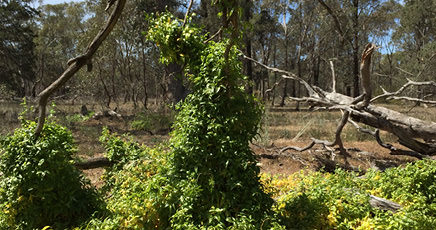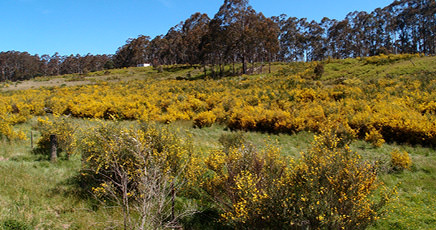STORY
Suyin and Tom decided to take Suyin’s little cousin Grace to the park when she came over to visit. Suyin saw that Grace loved to pick the dandelions from the ground and blow their little feathery tipped seeds while she made a wish. In as much as Suyin loved watching Grace make her wishes, Suyin had to ask Grace to stop what she was doing.
“Gracey, we mustn’t do that! When we blow the seeds of the dandelion, we are helping them spread and grow into places that they don’t belong. Did you know that the dandelions we find in our garden and parks are actually weeds? Weeds are plants that grow in places they aren’t wanted and can be harmful to our environment.” Suyin and Tom decided to show Grace how to bag the dandelion seeds to stop it from spreading, this would help native plants to grow instead.

Weeds compete with native plants in our natural environments, and can dominate both natural ecosystems and areas of agricultural production. This competition limits biodiversity, as well as the economic potential for farmers. This activity will look closely at three different weed forms and children will learn about their reproductive life cycles.
This learning activity is the first part of a sequence of 2 individual learning activities focused on understanding weeds. The order of these learning activities are: life cycle and investigation.
For children to:
- learn about weed features and compare with other plants
- undertake research about garden, bushland and agricultural weeds
- investigate weed plants and describe its form and dispersal mechanism
- value weed removal as important in maintaining biodiversity and agricultural productivity.
This activity can be undertaken any time of the year, however different plant parts of weeds develop depending on the season and their maturity. Identifying a weed’s life cycle stage will help determine its appropriate method of eradication.
Introduction
Weeds can look like any other plant, and can often even look very attractive.
However, a weed is a plant that grows where it is not wanted, and they are very successful in their reproduction. Learning about the life cycle of weeds can help us control and manage their spread, and understand the impact they have in the local environment.
*Time allocation will be dependent on site selection and travel time.
Checklist
Instructions
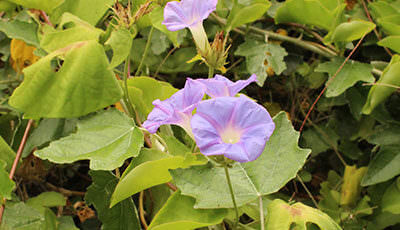
STEP 1
Tuning in
Take your group to the site selected to look at the flowering plants around you.
Discuss how flowering plant life cycles work from germination to flowering; with successful pollination leading to the creation of seeds in fruits. Look at plant features such as leaves, roots, flowers, nuts, fruits and seeds in their life cycle, and discuss why it might be successful.
Weeds are plants that grow where they are not wanted. Discuss how some flowering plants can be very successful weeds because they produce lots of seed, grow and spread very quickly. Weeds can have a variety of growth forms. This can include grass, tree, shrub, climbers, succulents and bulbs.
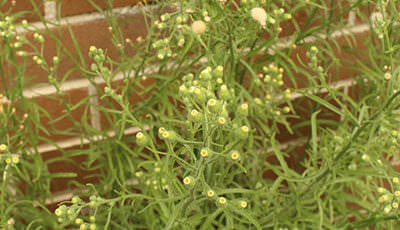
STEP 2
Delving deeper
What do we need to know about weeds?
Can you name any weeds?
What questions do we still have? Discuss and brainstorm in groups.
Using the activity sheet, talk through the life cycle of the Blackberry plant (shrub).
Discuss what the plant would look like through their lifecycle and ask the children to match this the diagram with the life cycle stage.
It helps to understand the specific features of the plant to learn ways weeds spread from seed into parks, gardens, paddocks and bushland in your area
Discuss the role that birds and animals play in dispersing the seed by eating the fruit and using the plant as habitat.
Why do you think weeds are a problem in the community?
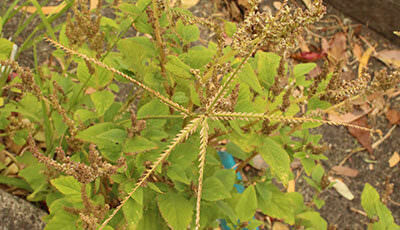
STEP 3
Honing in
To understand more about weeds, explore a digital or printed guide to help you. We have several listed in the reference list and recommend the visual stories about pest plants from EnviroStories as a great introduction.
Research more information about two weeds and look at their life cycle, their seeds and fruits, how their seeds are spread (dispersed) and what problems they cause.
Are there experts who can help with your investigations? Connect with your local Landcare group, parks, Indigenous Elders, council, groundsperson, gardeners or other weed experts to help you. Their wealth of knowledge and experience is valuable to increase knowledge in this important environmental and agricultural issue.
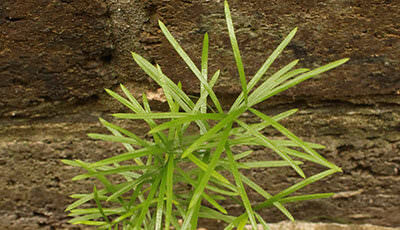
STEP 4
Processing and applying learning
What have you learnt about the life cycle of the weeds you have studied?
How can this help in the fight to get rid of these weeds?
What actions might you take to reduce the impact of such weeds?
Extension Activity
Come up with a strategy to remove weeds that you explored in this activity.
Use online resources or field guides to research a weed and create your own information sheet.
Curriculum and Framework Links
SCIENCE
Year 2: ACSSU030 (AC9S3U01), ACSHE035 (AC9S1H01; AC9S2H01)
Year 3: ACSSU044 (AC9S3U01), ACSIS054 (AC9S3I02; AC9S4I02)
Year 4: ACSHE062 (AC9S3H02), ACSIS064 (AC9S3I01; AC9S4I01)
Year 5: ACSHE083 (AC9S5H02; AC9S6H02) ACSSU043 (AC9S5U01)
Year 6: ACSSU094 (AC9S6U01)
Year 7: ACSHE120 (AC9S7H03; AC9S8H03)
Year 8: ACSHE135 (AC9S7H03; AC9S8H03)
HUMANITIES AND SOCIAL SCIENCES
Year 2: ACHASSI042
Year 3: ACHASSI052, ACHASSI060
Year 4: ACHASSK088, ACHASSK090
DESIGN AND TECHNOLOGIES
Year 7 and Year 8: ACTDEK032 (AC9TDE8K04)
HEALTH AND PHYSICAL EDUCATION
Year 2: ACPPS018
Year 3 and Year 4: ACPPS041
Year 5 and Year 6: ACPPS059
Year 7 and Year 8: ACPPS078
ETHICAL UNDERSTANDING
Exploring values, rights and responsibilities
PERSONAL AND SOCIAL CAPABILITY
Social awareness
CROSS CURRICULUM PRIORITY
Sustainability
MY TIME, OUR PLACE: FRAMEWORK FOR SCHOOL AGE CARE
Outcome 2 and 4
Reference List
ONLINE RESOURCES
We recommend the following websites as sources for more detailed information about weed species. For more detailed information please get in touch with your state or territory agricultural organising or local council.
Weeds Australia is a national database to search for weeds in Australia, this includes reference to Weeds of National Significance in Australia. Look at the Impact of weeds on the environment, agriculture and human health. The Weed Identification Tool helps you to Identify your weed by flower colour, plant form and location.
NSW Department of Primary Industry has some information on weeds along with best practice best practice weed management guides
Australian Native Plants Society has a series of information sheets about Environmental Weeds in Australia.
PRINTABLE RESOURCES
These educational resources will help support weed activities in your setting:
Print out or use online this series of stories about pest plants from EnviroStories. As they all are written by children and all contain some pictorial facts on local weeds.
Misbehaving plants from the University of New England is a picture PDF that includes some weed definitions and activities.
Future Farming – Weed Warriors Teachers Resource from Agriculture Victoria introduces activities and the Weed Warrior program for schools for students from Year 3 – Year 10.
The Weedbusters publication from Gould League provides a range of activities on learning about weeds.
Enviro-Stories shares stories through students telling their own stories; explore these stories about pest plants.
APPS
Some states and territories have applications to help you identify and report weeds in your location.
NSW
The NSW WeedWise App provides information on over 300 weed species.
QLD
The Weed Spotter App from the Weed Spotters Network Queensland allows you to email photographs of plants to the Queensland Herbarium.
SA
The SA Weed Control App provides essential information about the control of weeds declared under legislation in South Australia.
WATCH
In this video from ABC Education, find out about the native plants and animals found at Merri Creek, and about introduced plants (weeds) that are impacting this natural habitat. (3 minutes 30)
Sustainable Gardening Australia offers this entertaining video on how to manage weeds in Weeds, not in my backyard (5 minutes)
Learn about the Coastal Weeds Project with the Far South Coast Landcare Association (6 minutes 30).
ACKNOWLEDGEMENT
This learning activity has been developed in partnership with the Victorian Government Department of Environment, Land, Water and Planning. https://www.environment.vic.gov.au/
IMAGE ATTRIBUTION
Many thanks to Bec James, Victorian Department of Environment, Land, Water & Planning who has given permission to publish photos of:
- Wheel cactus (Opuntia robusta)
- Bridal creeper (Asparagus asparagoides)
- English or Scotch broom (Cytisus scoparius)
- Blackberry (Rubus fruticosus)
- African daisy (Gazania spp)
All other photos by Landcare Australia including:
- Morning glory
- Flaxleaf fleabane
- Crowsfoot grass
- Asparagus fern
We value your feedback
When you have finished this learning activity, please tell us what you think with our survey.
Your feedback will help Landcare Australia improve the activities in the Junior Landcare Learning Centre.
Why not try one of our other Junior Landcare learning activities?
Creating a butterfly garden
Biodiversity
Love Letters to the Land
Biodiversity|First Nations Perspectives|Food Production|Waste Management
Creating a sensory garden
Biodiversity
Understanding weeds: investigation
Biodiversity
